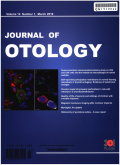- 钛学术文献服务平台 \
- 学术期刊 \
- 医药卫生期刊 \
- 五官科学期刊 \
- 中华耳科学杂志(英文版)期刊 \
Hyperacusis and stapes surgery:An observation infifty patients after stapedotomy
Hyperacusis and stapes surgery:An observation infifty patients after stapedotomy
基本信息来源于合作网站,原文需代理用户跳转至来源网站获取
摘要:
Objective: To assess hyperacusis after stapedotomy and its possible influencing factors.Study design: Prospective, interventional, and longitudinal study. Setting: A tertiary referral center. Patients: Fifty consecutive patients (35 females, mean age= 46.8 years). Intervention: All patients underwent stapedotomy. The validated Portuguese version of the"Hyperacusis Questionnaire"(HQ) was administered before and two weeks and one month after surgery. Results: No hyperacusis was reported by any patient before surgery. At two weeks after surgery, all patients experienced hyperacusis, with a mean HQ at 16.88 ± 6.54 (range 4-25). One month after sur-gery, hyperacusis had already resolved in most patients. Gender, preoperative presentation or surgeon had no influence on HQ scores (p > 0.05). Patients with previous contralateral stapedotomy showed lower HQ scores (p = 0.001). Audiological parameters improvement measured at one month after sur-gery (PTA, SRT and contralateral SRT) were associated with HQ higher scores. Conclusion: This study confirms that hyperacusis is a common complaint after stapedotomy that usually resolves in one month after surgery. The HQ highest scores were registered among patients with the highest audiological gain after surgery. This suggests that hyperacusis may be a positive prognostic factor for audiological success after stapedotomy.

推荐文章
探索 After Effects 在动画专业制作中的应用
After Effects(AE)
动画制作
功能应用
动画效果
After Effects制作微课方法初探
微课
教学
After Effects
Adobe After Effect插件原理及其实现
插件
PICA
COM
《联合创作》课程中Adobe After Effects教学模式的分析与改革
Adobe After Effects
教学优化
联合创作
内容分析
关键词云
关键词热度
相关文献总数
(/次)
(/年)
文献信息
| 篇名 | Hyperacusis and stapes surgery:An observation infifty patients after stapedotomy | ||
| 来源期刊 | 中华耳科学杂志(英文版) | 学科 | |
| 关键词 | |||
| 年,卷(期) | 2021,(1) | 所属期刊栏目 | Research Articles |
| 研究方向 | 页码范围 | 18-21 | |
| 页数 | 4页 | 分类号 | |
| 字数 | 语种 | 英文 | |
| DOI | |||
五维指标
引文网络
引文网络
二级参考文献 (0)
共引文献 (0)
参考文献 (14)
节点文献
引证文献 (0)
同被引文献 (0)
二级引证文献 (0)
1974(1)
- 参考文献(1)
- 二级参考文献(0)
1997(1)
- 参考文献(1)
- 二级参考文献(0)
2000(1)
- 参考文献(1)
- 二级参考文献(0)
2001(1)
- 参考文献(1)
- 二级参考文献(0)
2002(1)
- 参考文献(1)
- 二级参考文献(0)
2003(1)
- 参考文献(1)
- 二级参考文献(0)
2005(1)
- 参考文献(1)
- 二级参考文献(0)
2009(1)
- 参考文献(1)
- 二级参考文献(0)
2011(1)
- 参考文献(1)
- 二级参考文献(0)
2013(2)
- 参考文献(2)
- 二级参考文献(0)
2015(2)
- 参考文献(2)
- 二级参考文献(0)
2016(1)
- 参考文献(1)
- 二级参考文献(0)
2021(0)
- 参考文献(0)
- 二级参考文献(0)
- 引证文献(0)
- 二级引证文献(0)
引文网络交叉学科
相关学者/机构
期刊影响力
中华耳科学杂志(英文版)
主办单位:
解放军总医院耳鼻咽喉科研究所
出版周期:
季刊
ISSN:
1672-2930
CN:
11-4883/R
开本:
出版地:
北京市复兴路28号
邮发代号:
创刊时间:
语种:
eng
出版文献量(篇)
450
总下载数(次)
0
期刊文献
相关文献
推荐文献
- 期刊分类
- 期刊(年)
- 期刊(期)
- 期刊推荐

 免费查重
免费查重










